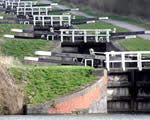 Go to main content
Go to main content
Archive Website of the UK government
Please note that this website has a UK government accesskeys system.
Main menu
Page menu
Travel and transport

Using your boat on inland waterways

The UK has over 4,000 miles of waterway enjoyed by millions of visitors every year. If you're interested in exploring these waterways by boat, find out how to get a navigational licence and comply with the Boat Safety Scheme.
License your boat to use it on inland waterways
You must have a navigational licence to use your pleasure boat to cruise on inland waterways, like canals or rivers. This applies to all types of boats, including:
- motor cruisers
- sailboats
- narrow boats
- open boats, like canoes and rowboats
There is a range of navigational licences available, from annual to shorter-term visitor licences. The type of licence you'll need depends on the sort of boat you have and where and how long you want to use it for. If you need a licence for your boat but don't register for one, you could be charged a penalty.
Most of the waterways are managed by navigation authorities. You need to contact the relevant navigation authority for your stretch of water for advice about licence requirements. British Waterways and the Environment Agency are the two major authorities in charge of canals and rivers in the UK. The Norfolk Broads are controlled by the Broads Authority. There is also a number of smaller authorities. For contact details of the navigation authorities for waterways not controlled by British Waterways, check the Boat Safety Scheme (BSS) website.
Make sure you have a Boat Safety Scheme certificate
If you use your boat on inland waterways controlled by British Waterways or the Environment Agency, you'll need a Boat Safety Scheme (BSS) certificate. You must send this with your application for a navigational licence. The only boats that don't need this certificate are privately owned open boats, like canoes and rowboats.
To receive a BSS certificate, you'll need to show a BSS examiner that your boat meets certain safety requirements on the BSS checklist. The checklist items are split into two categories:
- mandatory checks
- advisory checks
Mandatory checks
Your boat has to comply with all the mandatory checks before you can apply for a navigational licence. The mandatory checklist sets out essential safety requirements for your boat, like making sure you have taken certain measures to prevent fires and explosions.
Advisory checks
The advisory checklist sets out safety measures that are considered best practice for boating. Privately owned boats don’t have to comply with these items to get a licence, but it's strongly recommended that they do so. The more confidence you have that your boat meets the highest safety standards, the more you and your crew will enjoy your boating experience.
More information on BSS requirements and where to find an examiner can be found on the BSS website.
Owning or operating a commercial vessel on inland waterways
You'll need to comply with a code of practice if you own or operate a commercial vessel on inland waterways, like a:
- trip boat
- water taxi
- freight vessel
Follow the link below for more information.
Guidance on how inland waterways are categorised
If you use your boat on inland waterways in the UK, it's a good idea to understand how waterways are categorised. The different categories indicate how deep the water is and/or how high the waves can be expected to get.
It's especially important to understand the categories if you operate vessels commercially, particularly passenger vessels. You may have to comply with certain regulations depending on where you operate.
Follow the link below for detailed guidance from the Maritime and Coastguard Agency on how inland waterways are categorised.
 Facebook
Facebook Twitter
Twitter StumbleUpon
StumbleUpon Delicious
Delicious Reddit
Reddit
